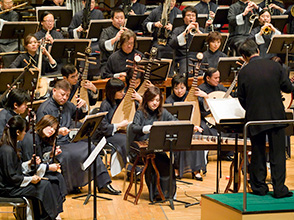Related Essays
An Introduction to Chinese Orchestras

China has a long history of musical ensembles; on rare imperial occasions, players could number in the hundreds. These, however, usually involved multiple players on a single part. The modern incarnation of Chinese orchestras—traditional instruments in symphonic groupings—dates back only to the 1950s, after the People’s Republic had called on China’s musical community to revolutionize the art for the Chinese people.
Much criticism in China had been leveled at Western music, but this nearly always concerned the repertory. The instruments themselves—primarily the violin and piano—were held up as models of modern design. It was within this environment—with makers being urged to adapt traditional instruments to comparable standards in pitch, flexibility, and timbre—that the instruments themselves came to be grouped in a Western manner.
Among the winds, the dizi (bamboo flutes) also covered the pitch range of Western alto and bass flutes. The sheng, a mouth organ (and ancient predecessor to both the pipe organ and the accordion), had been made chromatic, allowing for much greater harmonic function. The suona, essentially a double-reed pipe with a large bell, became the piercing equivalent of trumpets (and, in new larger, lower-pitched models, the trombone).
Bowed strings consisted (from high to low) of the gaohu, erhu, and zhonghu, which generally became orchestrated in split sections like Western violins and violas. Top orchestras often use the gehu and diyingehu, although due to their rarity most Chinese orchestras use their standard Western equivalents, the cello and double bass.
A section of the Chinese orchestra not often found in its Western model is plucked-strings, whose instruments come in various shapes, from the pear-like pipa to the round ruan. The dulcimer-like yangqin is generally placed in the middle of the orchestra, its function similar to the harpsichord in a Baroque ensemble.
Chinese percussion—the oldest of the instrument groups—divides into luo (gongs), gu (skin drums), bo (cymbals), bianzhong (literally, “grouped bells”), and various wooden instruments from bamboo clappers to temple blocks. Of all the groups, percussion arguably made the easiest transition, as several instruments such as gongs and temple blocks had already become standard instruments in the West.
Although the early pieces for these ensembles consisted mostly of folk-song arrangements, the Chinese orchestra now has an enormous repertory of new works. Thanks to aggressive commissioning efforts by organizations in Hong Kong, Taiwan, Singapore, and Macao, nearly every living Chinese composer has contributed to the repertory.



 Sponsored by
Sponsored by